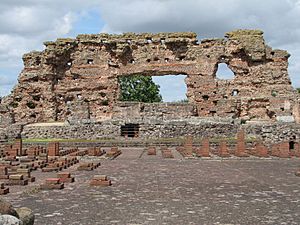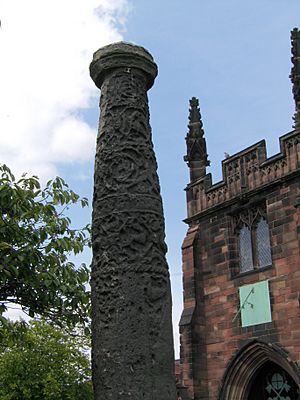Viroconium Cornoviorum facts for kids
Viroconium, also known as Uriconium, was a large Roman city in ancient Britain. Today, a small village called Wroxeter in Shropshire, England, sits on one part of its original site. This ancient city was once the fourth-largest Roman settlement in Britain, with an estimated population of over 15,000 people! You can still see many impressive remains of Viroconium today.

Remains of the public baths, known as "The Old Work"
|
|
| Location | Wroxeter, Shropshire, England |
|---|---|
| Region | Britannia |
| Coordinates | 52°40′27″N 02°38′39″W / 52.67417°N 2.64417°W |
| Type | Settlement |
Contents
What's in a Name? The Story of Viroconium
The name Viroconium comes from an older Celtic word. Experts believe this word, *Uiroconion, meant "city of *Uirokū." The name *Uirokū itself likely meant "man-wolf."
The original capital of the local British tribe, the Cornovii, was a strong hillfort on the Wrekin. This hillfort was also called *Uiroconion. When the Romans took control, they moved the capital to Wroxeter. They named it Viroconium. The extra part, "Cornoviorum," means "of the Cornovii." This helped everyone know it was the Viroconium belonging to that specific Celtic tribe.
Roman historians like Ptolemy and Suetonius wrote about this important city.
Viroconium's Roman History
Viroconium started as a Roman army camp. It was built early in the Roman conquest of Britain. A group of soldiers from Thrace first set up this camp. It was a key spot because it was near the end of Watling Street. This was a main Roman road across Britain. The camp also guarded the River Severn valley, which led into Wales. It protected the route south to the Wye valley.
Around the middle of the 1st century, a powerful Roman army unit, Legio XIV Gemina, took over the camp. They made it much bigger to prepare for invading Wales. In 78 AD, Governor Gnaeus Julius Agricola led campaigns against tribes in North Wales. Two years later, in 80 AD, Agricola took Legio XIV Gemina north. They went to fight the Picts in Scotland. After they left, another army unit, Legio XX Valeria Victrix, moved into the fortress.
By the late 80s, the Roman army no longer used the fort. Legio XX Valeria Victrix moved to another base. The civilian settlement that had grown around the fort began to turn into a town. Archaeologists found that an unfinished army bath house became the town's forum. A few years later, the old fort's layout was replaced by a new town street plan.
Building a Roman City
The large, columned forum began construction in the 120s. It covered the old, unfinished bath house. An inscription found during excavations shows it was finished in 130 AD. The town grew a lot, especially under Emperor Hadrian. It covered an area of over 173 acres (70 hectares). It had many public buildings, including large public baths. Simpler temples and shops have also been found.
At its busiest, Viroconium was one of the richest and fourth-largest Roman settlements in Britain. It had more than 15,000 people. Its wealth was surprising for a frontier town. This might be because it had good access to Wales and other trade routes.
Between 165 and 185 AD, the forum caught fire. Nearby shops and houses also burned. Many items from the shops were later found during digs. The forum was rebuilt with some changes.
Roman rule in Britain ended around 410 AD. After this, the Cornovii tribe split into two groups. This division led to Viroconium's decline as an important city.
Life After the Romans
Even after the Romans left, Viroconium remained important. It served as an early capital for the kingdom of Powys. It was also home to a group called the Wreocensæte, meaning 'inhabitants of Wroxeter'.
In 1967, the Wroxeter Stone was found. It has an inscription in an ancient Celtic language. This inscription is from around 460-475 AD. It shows that town life continued in Viroconium in the fifth century. However, many buildings started to fall apart.
Between 530 and 570 AD, most Roman towns were being abandoned. But Viroconium had a big rebuilding project. The old basilica was carefully taken down. New timber-framed buildings were put up on stone platforms. These likely included a very large two-story building. There were also storage buildings and houses. About 33 new buildings were "carefully planned and executed." They were "skillfully constructed" using Roman measurements. We don't know who started this rebuilding. It might have been a bishop. Some buildings were rebuilt three times. The community probably lasted about 75 years. Then, for some reason, many buildings were taken apart.
There is a story that Shrewsbury was founded in the 5th century. This happened because Viroconium was declining. One historian suggests Shrewsbury was strengthened by people fleeing a plague in Viroconium.
The site was likely left peacefully in the late 7th or early 8th century. The court of the Kingdom of Powys moved to Mathrafal before 717 AD. This move followed a time of famine and plague in Viroconium.
Preserving Viroconium Today
Even though some stone from Viroconium was used for nearby churches, many important remains still stand. These include "the Old Work," which is part of the baths. It is the largest free-standing Roman ruin in England. The remains of the baths complex are also visible.
These sites are open to the public. English Heritage looks after them under the name "Wroxeter Roman City." There is also a small museum. Some of the most important discoveries are kept in the Music Hall Museum in Shrewsbury. Most of the ancient town is still buried. However, experts have mapped much of it using special surveys and aerial photos.
Archaeologists are still working at the site. They continue to dig up and study more buildings.
A Reconstructed Roman Villa
In February 2011, a reconstructed Roman villa opened to visitors. It helps people understand Roman building methods. It also shows how Romans lived. A TV show called Rome Wasn't Built in a Day showed how it was built. They used real ancient techniques. Local volunteers helped the builders. An archaeologist named Dai Morgan Evans designed and supervised the villa's construction.
See also
 In Spanish: Viroconium para niños
In Spanish: Viroconium para niños




